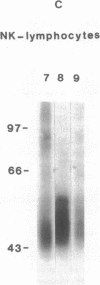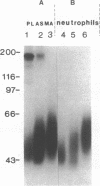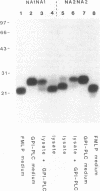Abstract
FcRIII (the CD16-antigen), a low affinity receptor for IgG, is expressed by neutrophils, natural killer lymphocytes, and macrophages. We have developed a sensitive radioimmunoassay to quantify FcRIII. A soluble form of FcRIII was identified in human plasma. Immunoprecipitation of FcRIII from plasma showed that the plasma form of FcRIII has an identical electrophoretic mobility as the FcRIII expressed by neutrophils. Moreover, the plasma form of FcRIII exhibited the same polymorphism as does the neutrophil FcRIII. The neutrophil expresses the phosphatidylinositol-linked form of FcRIII, encoded by the gene FcRIII-1. Because it is not known whether this gene is also active in nonhematopoietic cells, we analyzed patients with an acquired clonal disorder of their hematopoietic cells, paroxysmal nocturnal hemoglobinuria (PNH). PNH patients appeared to have a strongly reduced expression of FcRIII on their neutrophils. The concentration of FcRIII in the plasma of these patients was also reduced, indicating that plasma FcRIII originates from neutrophils. A patient deficient in FcRIII-1 but with a normal expression of FcRIII-2 had no soluble FcRIII in her plasma, also indicating that plasma FcRIII originates from neutrophils. The electrophoretic mobility of the protein backbone of plasma FcRIII and FcRIII released by activated neutrophils was identical, whereas deglycosylated FcRIII obtained from a lysate of neutrophils migrated slower. This indicates that plasma FcRIII originates from activation-induced release by neutrophils. Stimulation of neutrophils or neutrophil cytoplasts (closed membrane vesicles filled with cytoplasm) with low concentrations of FMLP (10(-9)-10(-8) M) or phorbol myristate acetate (1-10 ng/ml) induced a dose-dependent release of FcRIII. The plasma concentration of FcRIII was relatively constant (range 40-280% of the mean). Soluble FcRIII was also detected in inflamed joint fluids of arthritis patients, suggesting that FcRIII is also released by activated neutrophils in vivo.
Full text
PDF
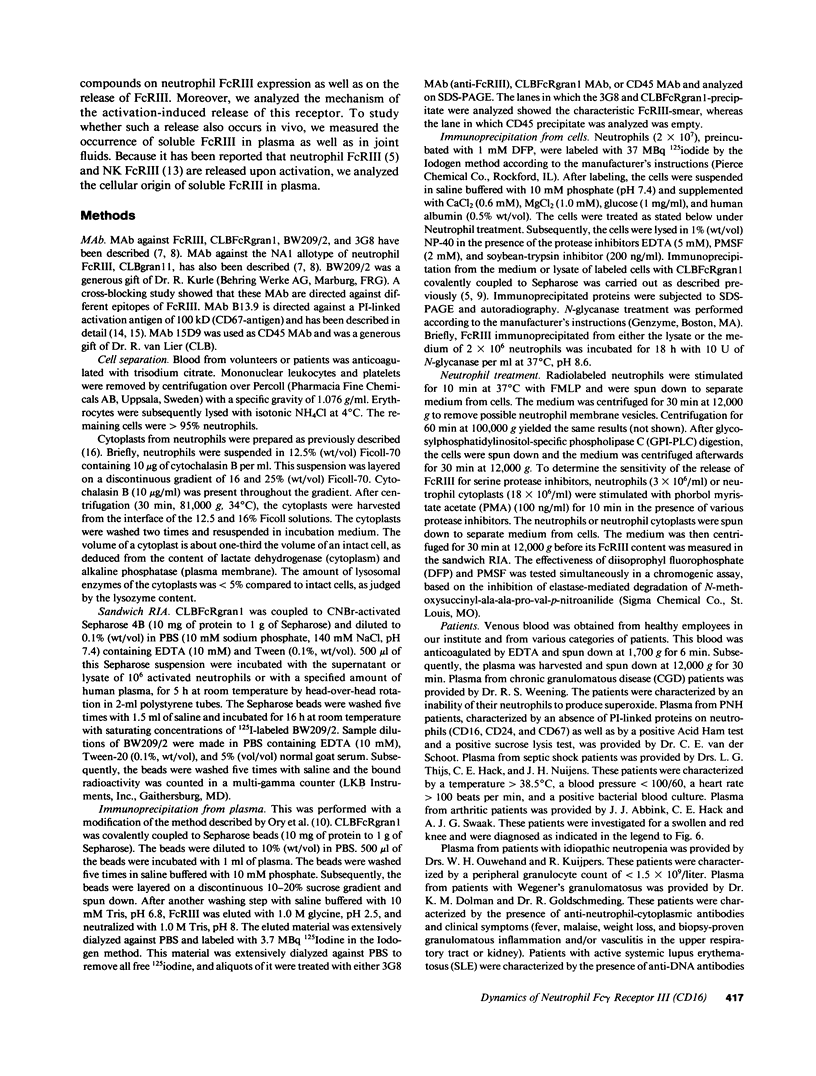
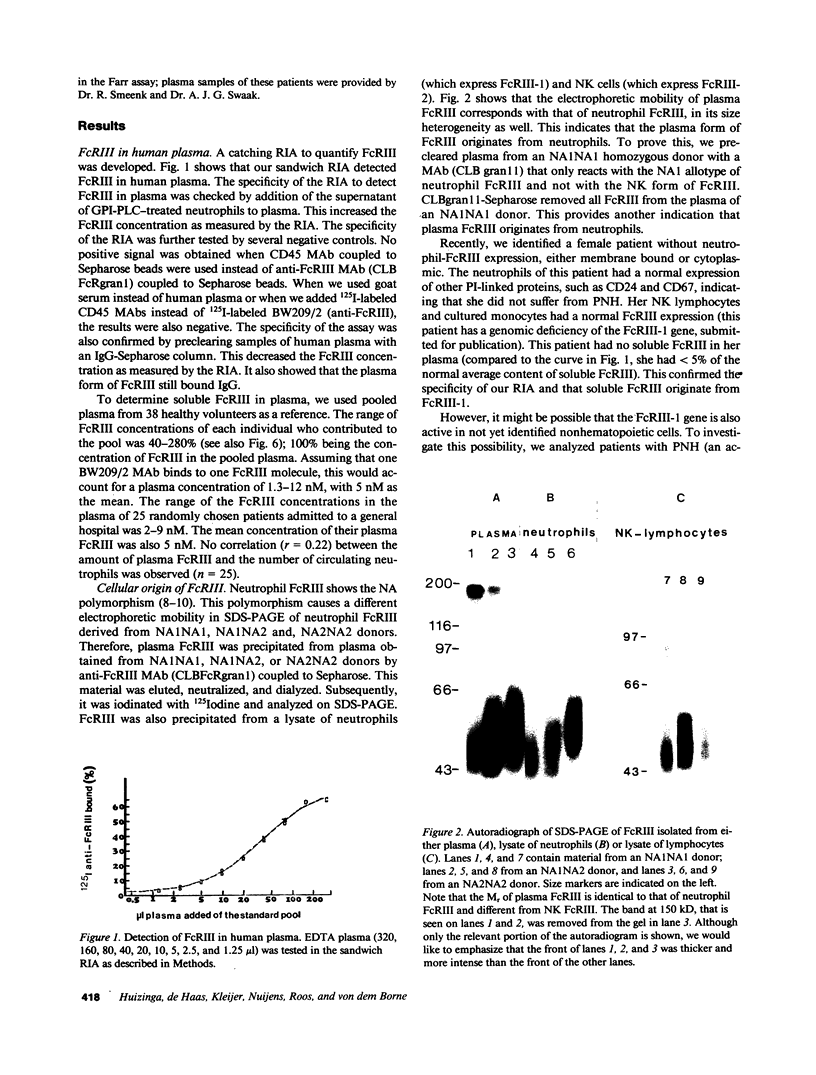
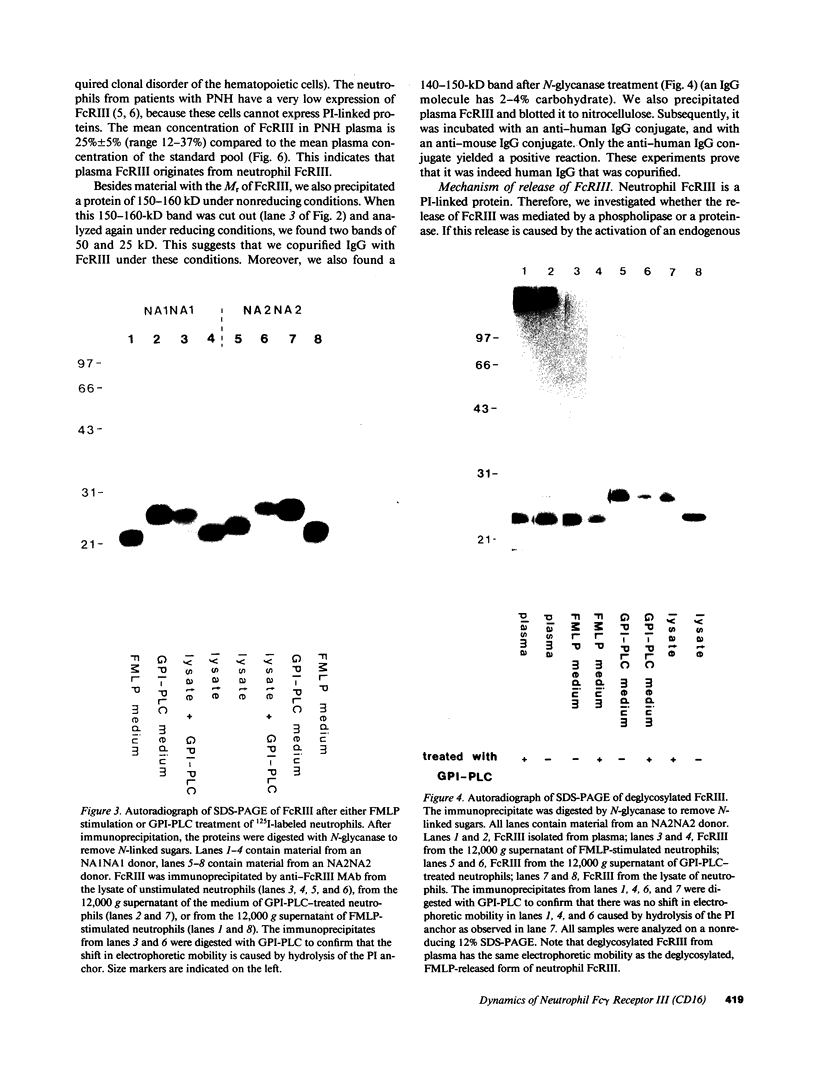
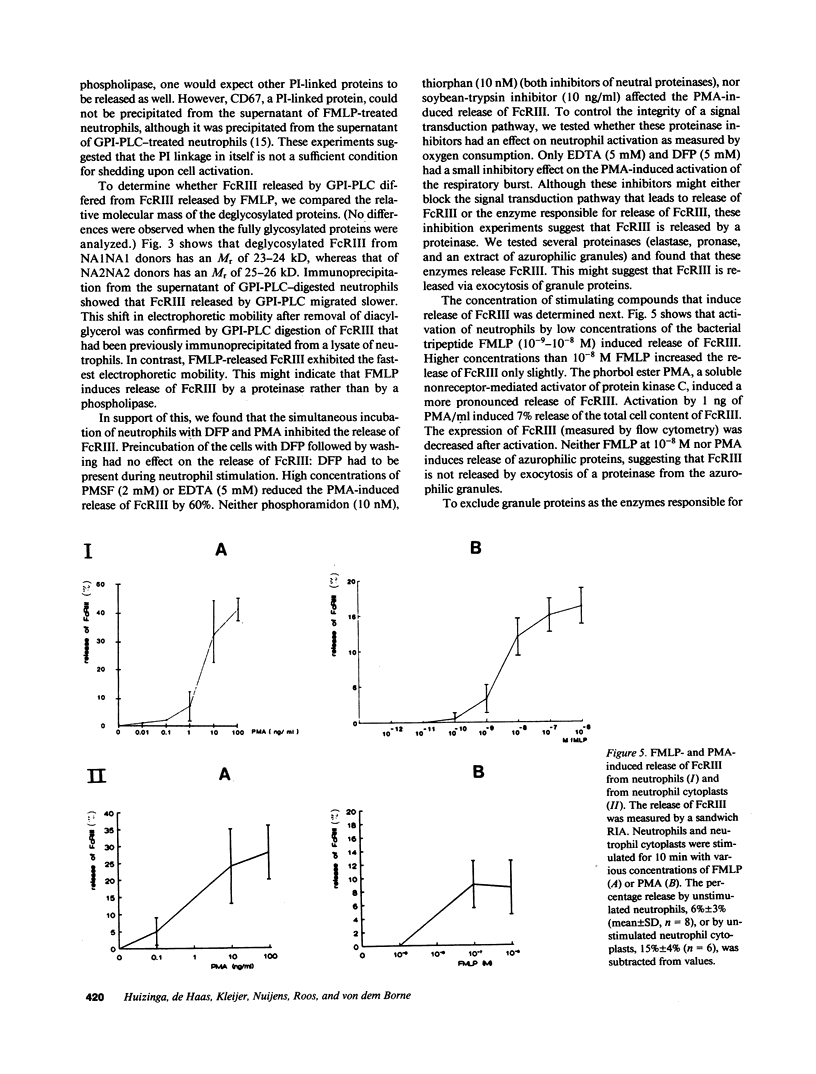
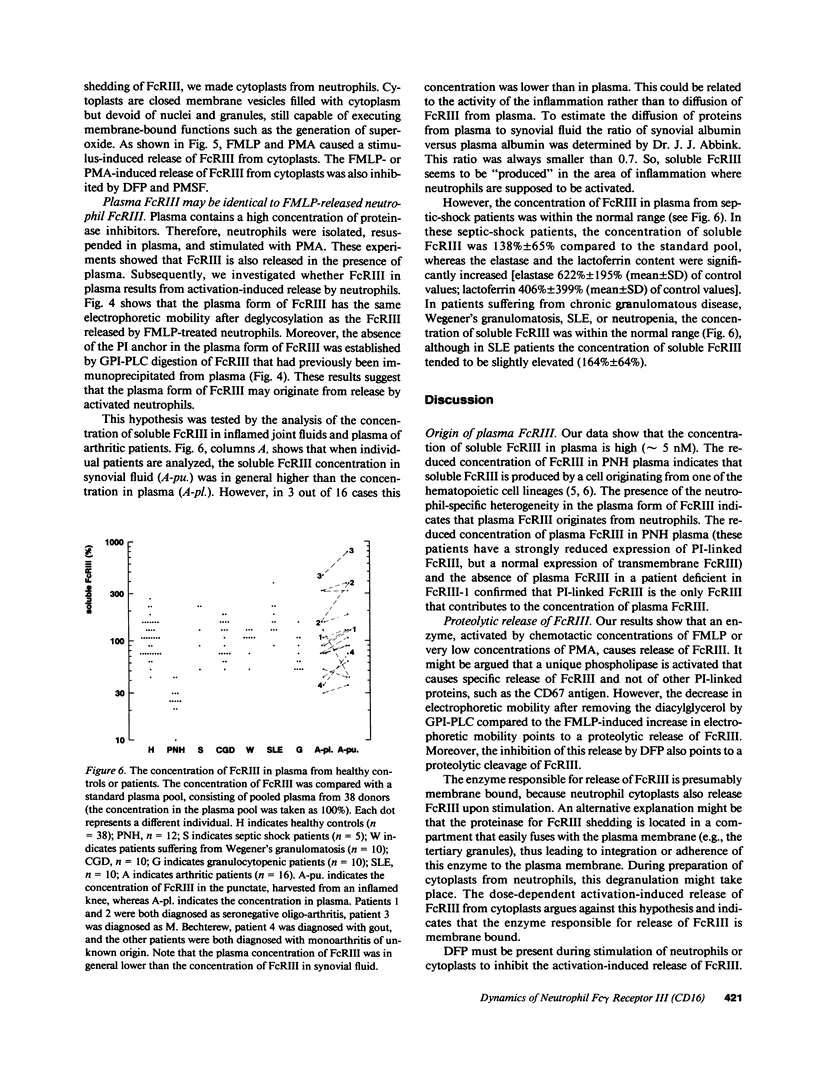
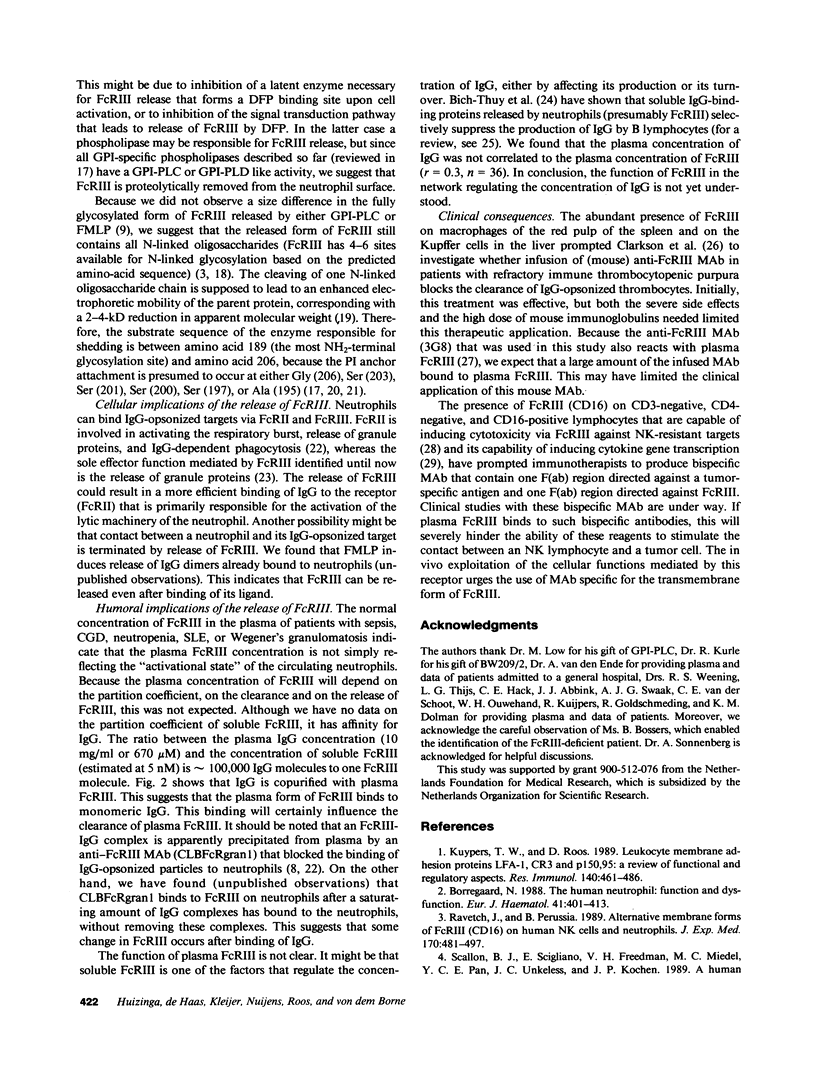

Images in this article
Selected References
These references are in PubMed. This may not be the complete list of references from this article.
- Anegón I., Cuturi M. C., Trinchieri G., Perussia B. Interaction of Fc receptor (CD16) ligands induces transcription of interleukin 2 receptor (CD25) and lymphokine genes and expression of their products in human natural killer cells. J Exp Med. 1988 Feb 1;167(2):452–472. doi: 10.1084/jem.167.2.452. [DOI] [PMC free article] [PubMed] [Google Scholar]
- Bartles J. R., Braiterman L. T., Hubbard A. L. Biochemical characterization of domain-specific glycoproteins of the rat hepatocyte plasma membrane. J Biol Chem. 1985 Oct 15;260(23):12792–12802. [PubMed] [Google Scholar]
- Bich-Thuy L. T., Samarut C., Brochier J., Revillard J. P. Suppression of the late stages of mitogen-induced human B cell differentiation by FC gamma receptors (FC gamma R) released from polymorphonuclear neutrophils. J Immunol. 1981 Oct;127(4):1299–1303. [PubMed] [Google Scholar]
- Borregaard N. The human neutrophil. Function and dysfunction. Eur J Haematol. 1988 Nov;41(5):401–413. doi: 10.1111/j.1600-0609.1988.tb00219.x. [DOI] [PubMed] [Google Scholar]
- Clarkson S. B., Bussel J. B., Kimberly R. P., Valinsky J. E., Nachman R. L., Unkeless J. C. Treatment of refractory immune thrombocytopenic purpura with an anti-Fc gamma-receptor antibody. N Engl J Med. 1986 May 8;314(19):1236–1239. doi: 10.1056/NEJM198605083141907. [DOI] [PubMed] [Google Scholar]
- Fc receptors as regulatory molecules. Ann Inst Pasteur Immunol. 1985 May-Jun;136C(3):383–437. [PubMed] [Google Scholar]
- Huizinga T. W., Dolman K. M., van der Linden N. J., Kleijer M., Nuijens J. H., von dem Borne A. E., Roos D. Phosphatidylinositol-linked FcRIII mediates exocytosis of neutrophil granule proteins, but does not mediate initiation of the respiratory burst. J Immunol. 1990 Feb 15;144(4):1432–1437. [PubMed] [Google Scholar]
- Huizinga T. W., Kleijer M., Tetteroo P. A., Roos D., von dem Borne A. E. Biallelic neutrophil Na-antigen system is associated with a polymorphism on the phospho-inositol-linked Fc gamma receptor III (CD16). Blood. 1990 Jan 1;75(1):213–217. [PubMed] [Google Scholar]
- Huizinga T. W., van Kemenade F., Koenderman L., Dolman K. M., von dem Borne A. E., Tetteroo P. A., Roos D. The 40-kDa Fc gamma receptor (FcRII) on human neutrophils is essential for the IgG-induced respiratory burst and IgG-induced phagocytosis. J Immunol. 1989 Apr 1;142(7):2365–2369. [PubMed] [Google Scholar]
- Huizinga T. W., van der Schoot C. E., Jost C., Klaassen R., Kleijer M., von dem Borne A. E., Roos D., Tetteroo P. A. The PI-linked receptor FcRIII is released on stimulation of neutrophils. Nature. 1988 Jun 16;333(6174):667–669. doi: 10.1038/333667a0. [DOI] [PubMed] [Google Scholar]
- Khayat D., Geffrier C., Yoon S., Scigliano E., Soubrane C., Weil M., Unkeless J. C., Jacquillat C. Soluble circulating Fc gamma receptors in human serum. A new ELISA assay for specific and quantitative detection. J Immunol Methods. 1987 Jun 26;100(1-2):235–241. doi: 10.1016/0022-1759(87)90194-3. [DOI] [PubMed] [Google Scholar]
- Kurosaki T., Ravetch J. V. A single amino acid in the glycosyl phosphatidylinositol attachment domain determines the membrane topology of Fc gamma RIII. Nature. 1989 Dec 14;342(6251):805–807. doi: 10.1038/342805a0. [DOI] [PubMed] [Google Scholar]
- Kuypers T. W., Roos D. Leukocyte membrane adhesion proteins LFA-1, CR3 and p150,95: a review of functional and regulatory aspects. Res Immunol. 1989 Jun-Aug;140(5-6):461–486. doi: 10.1016/0923-2494(89)90114-4. [DOI] [PubMed] [Google Scholar]
- Lanier L. L., Cwirla S., Yu G., Testi R., Phillips J. H. Membrane anchoring of a human IgG Fc receptor (CD16) determined by a single amino acid. Science. 1989 Dec 22;246(4937):1611–1613. doi: 10.1126/science.2531919. [DOI] [PubMed] [Google Scholar]
- Lanier L. L., Phillips J. H., Testi R. Membrane anchoring and spontaneous release of CD16 (FcR III) by natural killer cells and granulocytes. Eur J Immunol. 1989 Apr;19(4):775–778. doi: 10.1002/eji.1830190431. [DOI] [PubMed] [Google Scholar]
- Low M. G. The glycosyl-phosphatidylinositol anchor of membrane proteins. Biochim Biophys Acta. 1989 Dec 6;988(3):427–454. doi: 10.1016/0304-4157(89)90014-2. [DOI] [PubMed] [Google Scholar]
- Ory P. A., Clark M. R., Kwoh E. E., Clarkson S. B., Goldstein I. M. Sequences of complementary DNAs that encode the NA1 and NA2 forms of Fc receptor III on human neutrophils. J Clin Invest. 1989 Nov;84(5):1688–1691. doi: 10.1172/JCI114350. [DOI] [PMC free article] [PubMed] [Google Scholar]
- Ory P. A., Goldstein I. M., Kwoh E. E., Clarkson S. B. Characterization of polymorphic forms of Fc receptor III on human neutrophils. J Clin Invest. 1989 May;83(5):1676–1681. doi: 10.1172/JCI114067. [DOI] [PMC free article] [PubMed] [Google Scholar]
- Peltz G. A., Grundy H. O., Lebo R. V., Yssel H., Barsh G. S., Moore K. W. Human Fc gamma RIII: cloning, expression, and identification of the chromosomal locus of two Fc receptors for IgG. Proc Natl Acad Sci U S A. 1989 Feb;86(3):1013–1017. doi: 10.1073/pnas.86.3.1013. [DOI] [PMC free article] [PubMed] [Google Scholar]
- Ravetch J. V., Perussia B. Alternative membrane forms of Fc gamma RIII(CD16) on human natural killer cells and neutrophils. Cell type-specific expression of two genes that differ in single nucleotide substitutions. J Exp Med. 1989 Aug 1;170(2):481–497. doi: 10.1084/jem.170.2.481. [DOI] [PMC free article] [PubMed] [Google Scholar]
- Roos D., Voetman A. A., Meerhof L. J. Functional activity of enucleated human polymorphonuclear leukocytes. J Cell Biol. 1983 Aug;97(2):368–377. doi: 10.1083/jcb.97.2.368. [DOI] [PMC free article] [PubMed] [Google Scholar]
- Scallon B. J., Scigliano E., Freedman V. H., Miedel M. C., Pan Y. C., Unkeless J. C., Kochan J. P. A human immunoglobulin G receptor exists in both polypeptide-anchored and phosphatidylinositol-glycan-anchored forms. Proc Natl Acad Sci U S A. 1989 Jul;86(13):5079–5083. doi: 10.1073/pnas.86.13.5079. [DOI] [PMC free article] [PubMed] [Google Scholar]
- Selvaraj P., Rosse W. F., Silber R., Springer T. A. The major Fc receptor in blood has a phosphatidylinositol anchor and is deficient in paroxysmal nocturnal haemoglobinuria. Nature. 1988 Jun 9;333(6173):565–567. doi: 10.1038/333565a0. [DOI] [PubMed] [Google Scholar]
- Tetteroo P. A., Bos M. J., Visser F. J., von dem Borne A. E. Neutrophil activation detected by monoclonal antibodies. J Immunol. 1986 May 1;136(9):3427–3432. [PubMed] [Google Scholar]
- Trounstine M. L., Peltz G. A., Yssel H., Huizinga T. W., von dem Borne A. E., Spits H., Moore K. W. Reactivity of cloned, expressed human Fc gamma RIII isoforms with monoclonal antibodies which distinguish cell-type-specific and allelic forms of Fc gamma RIII. Int Immunol. 1990;2(4):303–310. doi: 10.1093/intimm/2.4.303. [DOI] [PubMed] [Google Scholar]
- Werfel T., Uciechowski P., Tetteroo P. A., Kurrle R., Deicher H., Schmidt R. E. Activation of cloned human natural killer cells via Fc gamma RIII. J Immunol. 1989 Feb 15;142(4):1102–1106. [PubMed] [Google Scholar]



